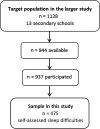Reasons for sleeping difficulties as perceived by adolescents: a content analysis
- PMID: 31487078
- PMCID: PMC7328685
- DOI: 10.1111/scs.12750
Reasons for sleeping difficulties as perceived by adolescents: a content analysis
Abstract
Sleeping difficulties are increasingly prevalent among adolescents worldwide and have negative consequences for adolescent health and education. The aim of this study was to describe the reasons for sleeping difficulties as perceived by adolescents. Sleeping difficulties include insufficient sleep, trouble falling asleep, waking up at night or sleep that does not leave an individual rested. Data were collected in 2015 using an open-ended question. The sample consisted of n = 475 adolescents from a city in Sweden, aged 15-16 years, with self-assessed sleeping difficulties. The results described the reasons for the adolescents' sleeping difficulties, at a general, thematic level, as an imbalance between requirements and preconditions, distributed to stress, technology use, poor sleep habits, existential thoughts, needs and suffering. To find a balance in their daily lives, adolescents may need support from parents, school nurses and school health services to deal with their sleeping difficulties.
Keywords: adolescent; content analysis; perception; questionnaire; sleeping difficulties.
© 2019 The Authors. Scandinavian Journal of Caring Sciences published by John Wiley & Sons Ltd on behalf of Nordic College of Caring Science.
Conflict of interest statement
The authors declared no potential conflicts of interest with respect to the research, authorship and/or publication of this article.
Similar articles
-
Sleep duration and sleeping difficulties among adolescents: exploring associations with school stress, self-perception and technology use.Scand J Caring Sci. 2019 Mar;33(1):197-206. doi: 10.1111/scs.12621. Epub 2018 Oct 12. Scand J Caring Sci. 2019. PMID: 30311255
-
"I Want to Sleep, but I Can't": Adolescents' Lived Experience of Sleeping Difficulties.J Sch Nurs. 2022 Oct;38(5):449-458. doi: 10.1177/1059840520966011. Epub 2020 Oct 16. J Sch Nurs. 2022. PMID: 33063632 Free PMC article.
-
[Sleep in adolescents and its disorders. A survey in schools].Encephale. 2004 Jul-Aug;30(4):352-9. doi: 10.1016/s0013-7006(04)95447-4. Encephale. 2004. PMID: 15538310 French.
-
Sleep and circadian difficulties in schizophrenia: presentations, understanding, and treatment.Psychol Med. 2025 Feb 17;55:e47. doi: 10.1017/S0033291725000297. Psychol Med. 2025. PMID: 39957506 Free PMC article. Review.
-
[Etiology of adult insomnia].Encephale. 2002 Nov-Dec;28(6 Pt 1):493-502. Encephale. 2002. PMID: 12506261 Review. French.
Cited by
-
School start time vs school end time: which works better for sleep?J Clin Sleep Med. 2023 Nov 1;19(11):1853-1854. doi: 10.5664/jcsm.10806. J Clin Sleep Med. 2023. PMID: 37644878 Free PMC article. No abstract available.
-
Association between Physical Activity and Sleep Difficulties among Adolescents in Germany: The Role of Socioeconomic Status.Int J Environ Res Public Health. 2021 Sep 14;18(18):9664. doi: 10.3390/ijerph18189664. Int J Environ Res Public Health. 2021. PMID: 34574590 Free PMC article.
-
Sleep apnea in people with Down syndrome: Causes and effects of physical activity?Front Neurol. 2023 Feb 2;14:1123624. doi: 10.3389/fneur.2023.1123624. eCollection 2023. Front Neurol. 2023. PMID: 36816555 Free PMC article. Review.
-
School nurses' experiences of health-promoting work to prevent stress in Swedish adolescents.Front Psychol. 2022 Jul 27;13:933879. doi: 10.3389/fpsyg.2022.933879. eCollection 2022. Front Psychol. 2022. PMID: 35967686 Free PMC article.
-
Reducing the impact of peer victimization on adolescent insomnia: Which is more important, peers or family support?Front Psychiatry. 2025 Feb 19;16:1487715. doi: 10.3389/fpsyt.2025.1487715. eCollection 2025. Front Psychiatry. 2025. PMID: 40066136 Free PMC article.
References
-
- Gradisar M, Gardner G, Dohnt H. Recent worldwide sleep patterns and problems during adolescence: a review and meta‐analysis of age, region, and sleep. Sleep Med 2011; 12: 110–18. - PubMed
-
- Ghekiere A, Van Cauwenberg J, Vandendriessche A, Inchley J, Gaspar de Matos M, Borraccino A, Gobina I, Tynjälä J, Deforche B, De Clercq B. Trends in sleeping difficulties among European adolescents: are these associated with physical inactivity and excessive screen time? Int J Public Health 2018; 1–12. - PubMed
-
- National Sleep Foundation . National Sleep Foundation Recommends new Sleep Times [Internet]. 2017, National Sleep Foundation, https://sleepfoundation.org/press-release/national-sleep-foundation-reco... (last accessed 3 April 2019).
-
- Matricciani L, Olds T, Petkov J. In search of lost sleep: secular trends in the sleep time of school‐aged children and adolescents. Sleep Med Rev 2012; 16: 203–11. - PubMed
MeSH terms
Grants and funding
LinkOut - more resources
Full Text Sources
Medical


